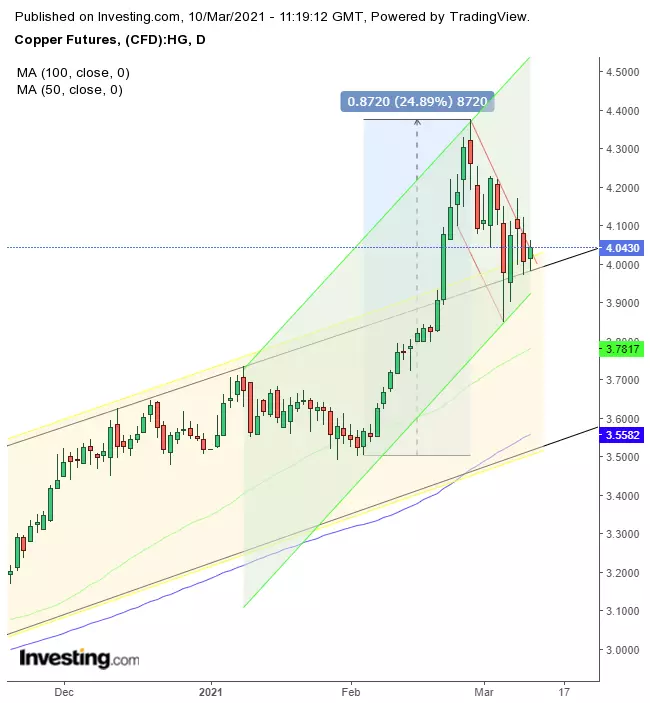Recently, the market has broken down discussions about the possibility of a surge inflation. They found both opponents of strengthening price pressure and those that consider this phenomenon positive for markets and the economy.
This is what optimists say: Reflation (i.e., accelerating economic growth with stimuli) is useful because growing prices contribute to economic growth, allowing companies to increase profits, staff and wages, thereby increasing the disposable paths of meditation. This concept involves the controlled ascending "spiral" of economic growth.
A negative view involves overheating of the economy and too sharp price splash. If prices are ahead of the growth rate of the profits of companies and the purchasing power of consumers, then over time the economy begins to decline.
Naturally, at this stage it is impossible to say who will be right. However, we can develop trading models for both scenarios that will insure capital (and ideally to earn).
Today we will consider the copper market, which will benefit the "stimulated" economic growth, and in the following article, we will discuss more in more detail on platinum used as protection against fast-growing inflation.

Red metal rose by 25% in just three weeks (from a minimum of February 3 to peak on February 25). Copper reached the level of August 2011 and is now trading about 5% below the record peak of February 14.
This rally struck the upper border of the rising channel, in which the metal moved from the Martov minimum.
Obviously, the predominance of demand contributes to price increases. However, in this case it is interesting that the same traders seem to play for both sides.
When the scales bowed in favor of demand, the metal was able to change the course and quickly strengthen. If we are right, then the 25 percent rally is only the first part of the movement.
The flag marks the range in which the "bulls" fix profits, fearing the fact that prices soared too quickly and high. Please note that the decline has a smoother character than the previous movement.
This is because traders agree with the ascending trend. The accumulation of positions inside the flag shows that there is no more consensus.
The initial "bulls" became sellers who are taking profit, while new buyers pick up positions in the hope of similar progress. So, the flag is a downward nature due to the fixation of the profits. It is still formed, since all the contracts sold easily find new owners.
In technical analysis it is important to look at the picture in general and form order from chaos. Please note that the flag has found support at the rising channel.
Another important point: the tilt of the 50-period DMA becomes sharper, while the 100-period DMA first crossed the base of the rising channel.
Characteristics of a futures contract for copper
- Unit: 25,000 pounds
- Quotation price: Dollars and cents per pound (multiply every price change by 25,000 and get a change in the cost of the contract).
In other words:
- Minimum contract price change: 0.0005 * 25 000 = $ 12.50
Trading strategies
Conservative traders should wait for the ascending breakdown of the flag and level 4.2000; Subsequent short compression and rollback will repeat the integrity of the model, and the demand must run another wave of price increases.
Moderate traders will wait for the breakdown of the 4,120 mark and the subsequent rollback to minimize the stop loss.
Aggressive traders can buy already now, provided that they understand the dynamics and are aware of the risks. Hard trading plan - the key to success.
An example of an aggressive position
- Login: 4.0000;
- Stop loss: 3.9000;
- Risk: 0.1000 * 25 000 = $ 2,500;
- Target: 4.3000;
- Profit: 0.3000 * 25 000 = $ 7,500;
- Risk ratio to profits: 1: 3.
Author's note: This is nothing more than an example of a position reflecting one of the ways of trading in this particular situation. Moreover, the interpretation of market dynamics may be incorrect. We do not know the future, but simply appreciate the picture. Our expectations are based on statistics. The more you traded, the more chances you have to be on the "right side" of statistics. In addition to analytics, man-management is crucial. Your temperament, budgetary and temporary limitations will also influence the results of trade. Until you learn how to configure a trading plan for yourself, gain experience in small positions. Thoughtless use of the strategy in the pursuit of fast money is fraught with the loss of all means. Ultimately, the accomplicity for your money lies with you, and not on analysts or other market participants. Think about it before making a decision.
Read Original Articles on: Investing.com
